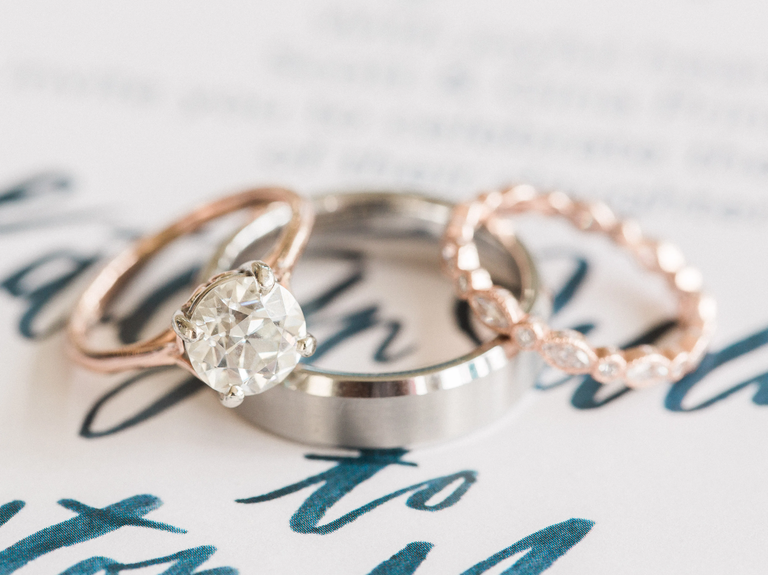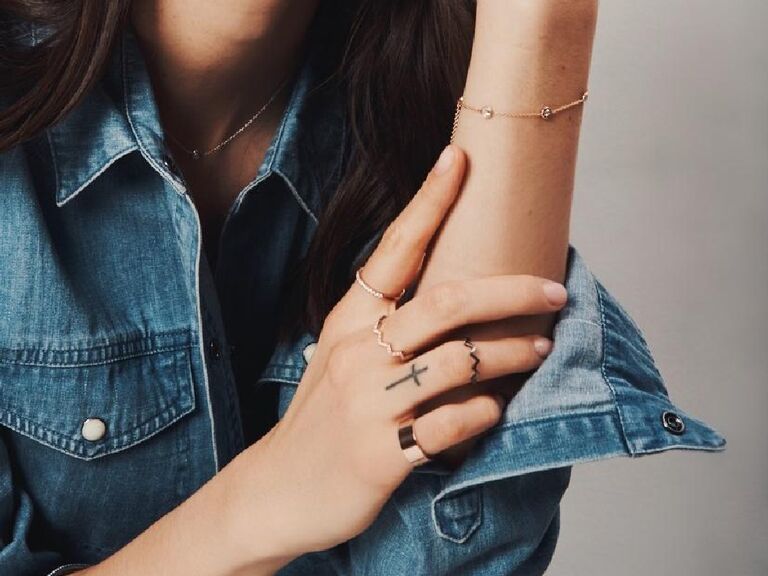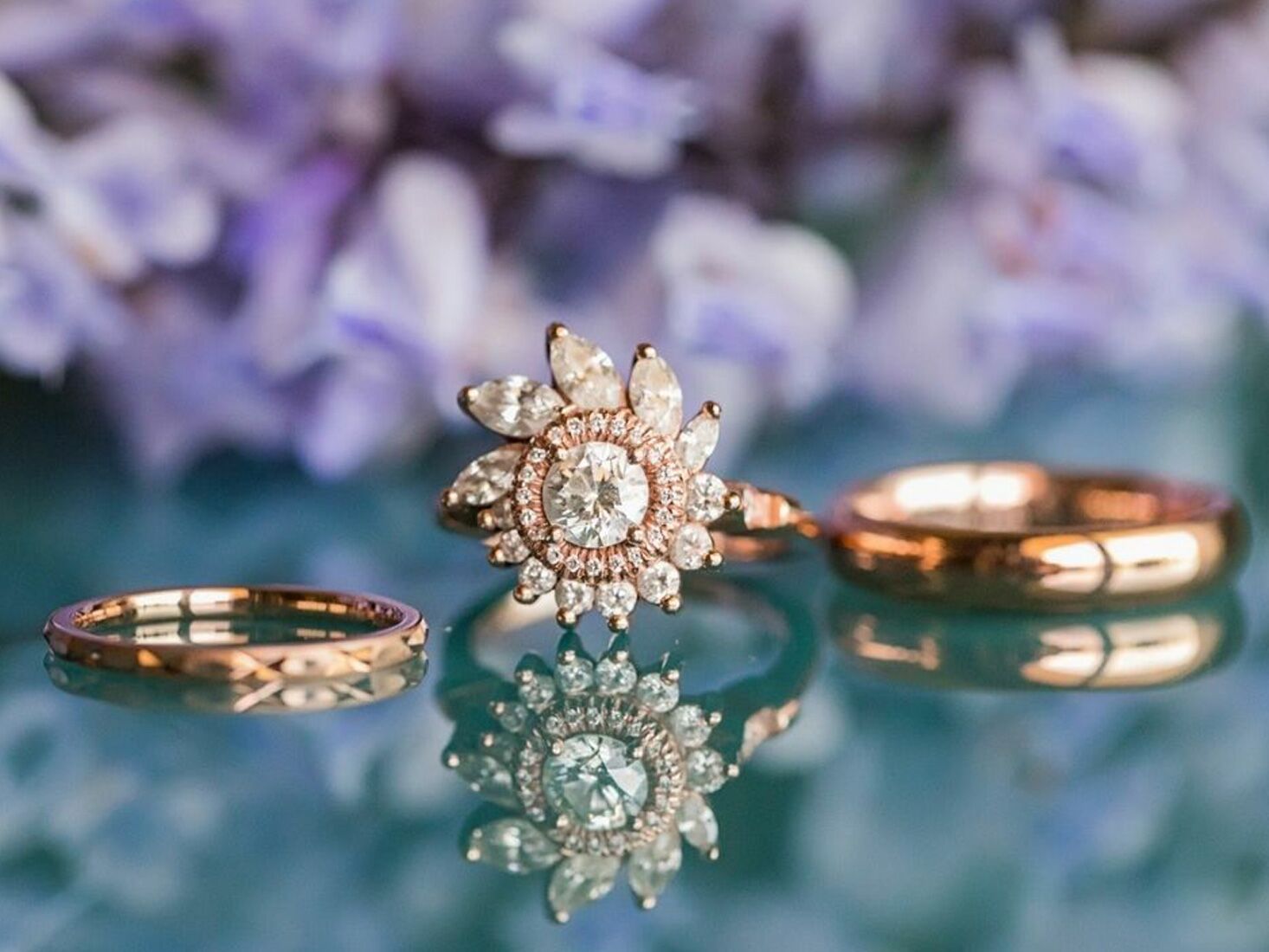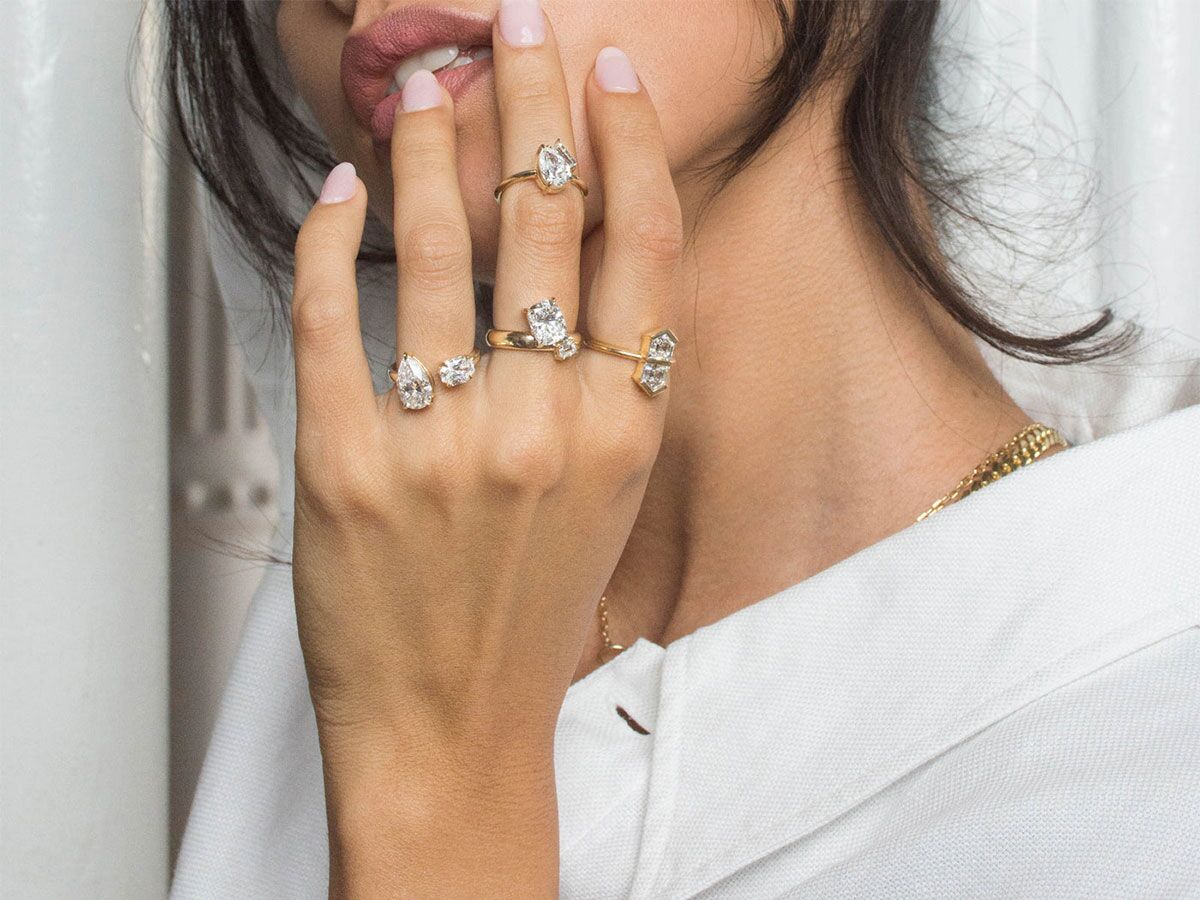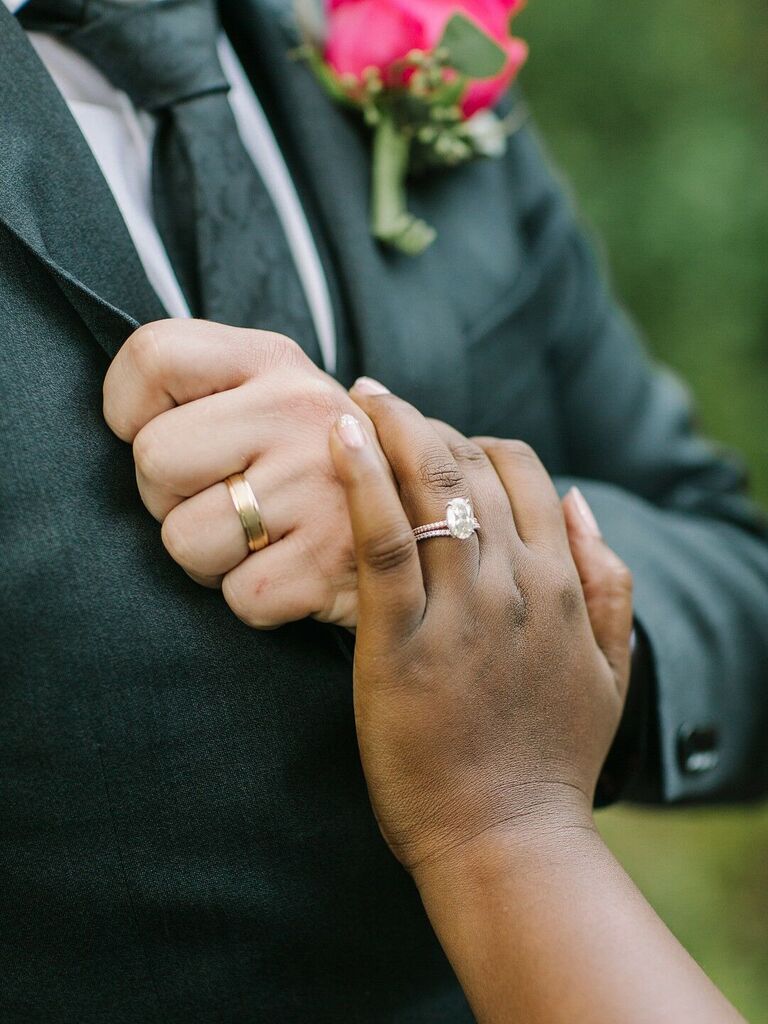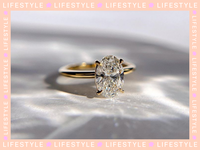Your Guide to The Best Ring Metals for Engagement Rings
Everything that glitters is most decidedly not gold as evidenced by the plethora of ring metals available to those getting ready to pop the question this engagement season. As much as any element in the journey to the aisle, the engagement ring stylistically sets the stage for the events that will follow and while it's easy to be distracted by the ice skating rink-sized diamonds that so often garner the most attention (we've got a guide to those too), you've got to start with a strong foundation. That's where choosing the perfect ring metal comes into play.
Your choice of engagement ring metal is as much about style as it is solidity and should complement your ring's design and featured stones. And just like stones, the most popular ring metals come in a spectrum of colors and strengths, which should be taken into account when choosing an engagement ring that will stand the test of time not only aesthetically but structurally. Consider this another indispensable guide in your search for the perfect engagement ring, filled with expert jeweler advice on every metal from white gold to tungsten, that will serve you well no matter your style or budget as you determine which ring metal is best for you.
In this article:
- Types of Ring Metals for Engagement Rings
- How to Pick The Best Metal for Your Engagement Ring
- FAQs About Engagement Ring Metals
Types of Ring Metals for Engagement Rings
While some metals may win the popularity contest, that doesn't necessarily mean they're the right choice for you. Work with your hands? Platinum will offer a more secure setting for your precious stones. Read on for the pros and cons of the metals you'll likely encounter when you begin your search.
White Gold Ring Metal
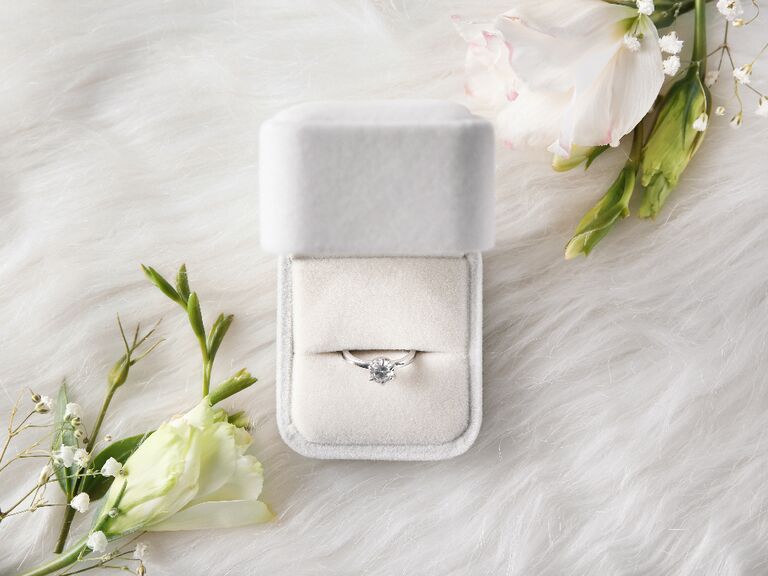
According to The Knot 2021 Jewelry & Engagement Study, which surveyed over 5,000 recently engaged couples, white gold is the most popular choice for engagement ring metals—it accounts for 41% of engagement rings. Though it has a similar silvery finish to platinum, white gold rings are made through an entirely different process. "White gold is made from mixing yellow gold with alloys," says Brantner. This material is then completed with rhodium plating to give it a bright finish.
While it's true that white gold is a durable option and can sometimes be a more budget-friendly alternative to platinum, its mixed base will require replating after frequent wear. "White gold will change color over time depending on the alloys used to create its color, as well as its interaction with body oil, the environment where it's worn, and other chemicals," says Brinkman. So, while white gold is a common ring metal type, it requires more upkeep to preserve its pristine finish.
Yellow Gold Ring Metal
As the purest of all gold ring metal types, a yellow gold engagement ring or band is the most hypoallergenic and the easiest to maintain. Plus, because yellow gold rings are purer than others, it's better for jewelers to manipulate. (Read: If you want an engagement ring with an ornate or intricate setting, it may be easier to achieve with a yellow gold band.) Yellow gold is also particularly flattering to warmer skin tones, as well as diamonds of a lower color grade. This offers plenty of flexibility when it comes to picking a center stone to sit on a yellow gold band. The color is also on the rise in terms of popularity. Our study found that 15% of engagement rings have a yellow gold metal, up from 10% in 2020.
Rose Gold Ring Metal
Like its name implies, rose gold metal has a gold base with a pinkish tint. It's an alloy that's made by combining pure gold, copper and a hint of silver. The higher the copper content, the pinker the rose gold. Rose gold rings tend to look a bit trendier given their pink hue, making it a good choice for wearers who don't want a traditional silver or gold band. In fact, our study found that 13% of all engagement rings are rose gold. And, because rose gold metal has a warmer finish, it can be paired with a stone that's higher on the color scale. "A stone with a warmer color is better set in a yellow or rose gold metal to mask a bit of the warmth," Brinkman says.
One thing to beware of is the purity of the rose gold metal. While pure rose gold is very durable, rose-gold plated jewelry is prone to tarnishing and oxidizing over time. Be extra-selective when it comes to this ring metal type, as it's better to splurge on the true metal to prolong its finish and avoid corrosion long-term.
Platinum Ring Metal
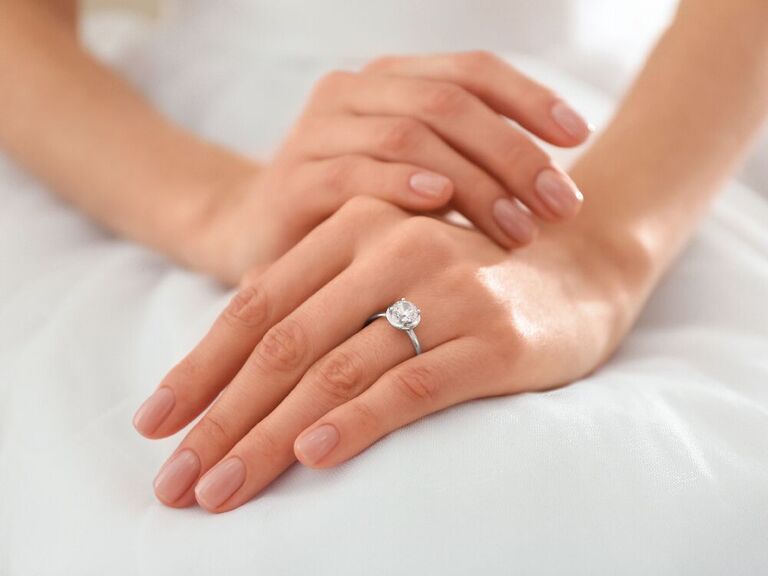
If you're curious to know the most durable engagement ring metal, most jewelers report that platinum takes the top spot. "Platinum is the most durable metal in the long run," explains Brantner. "While it shows dents, dings and scratches just like gold, over time platinum acquires a patina, which is a duller finish and it loses less metal mass over the years compared to gold." And, according to our data, platinum accounts for 8% of all engagement rings.
Platinum is one of the best metals for engagement and wedding rings because it won't tarnish a lot. Plus, because it's so durable, it'll keep your ring super secure—but this means that it does come at a higher cost. The heightened price can be attributed to its rarity and purity. While other metals are created with alloys to achieve the silvery-white look, a platinum wedding ring's color comes naturally. "Platinum is the most expensive metal for jewelry," Brantner confirms. "While gold market prices may seem higher at times, platinum must only be alloyed with other members of the platinum metal group. It's also harder to work with and requires more finishing steps than gold. It is an investment up front, however, it pays off in the long run with fewer maintenance fees."
Palladium Ring Metal
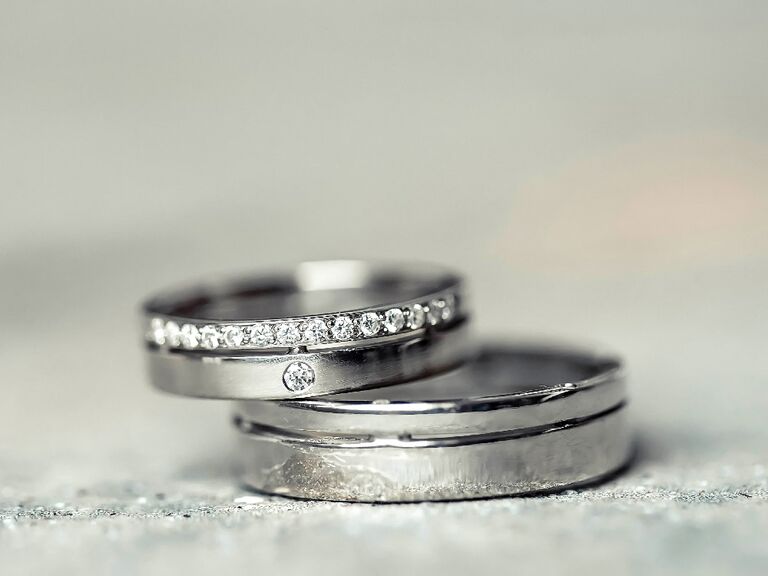
In recent years, palladium rings have risen in demand. Because of its silvery-white luster, this precious metal is often compared to platinum. And, while there are some key differences between these ring metal types, it's becoming a popular metal for engagement rings and wedding bands. "Like platinum, palladium is a harder metal, therefore making it scratch-resistant and more durable," says Brinkman, noting that it can retain its color longer than other ring styles. "While the changing of metal is inevitable, some alloys like palladium can help the ring maintain more of a white color for a longer period of time."
While the cost of a palladium ring depends on its market demand, some couples find that this can serve as a budget-friendly alternative to a platinum ring, especially because they share similar qualities. If you and your S.O. have your sights set on silver rings, palladium can be an alternative to platinum if it's out of your price range.
Tungsten Ring Metal
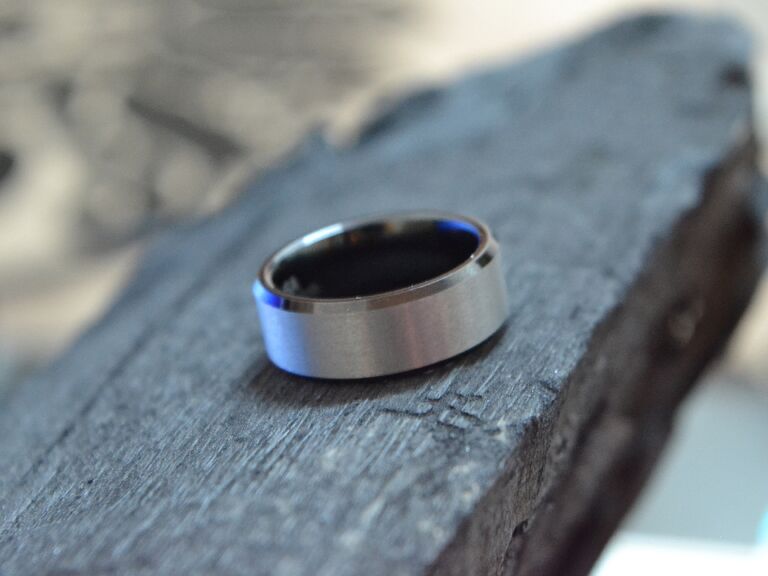
Most often used for men's wedding bands, tungsten carbide, which accounts for 2% of all engagement rings, is much harder than any other type of metal. Created by combining tungsten and carbon atoms, tungsten rings are very scratch-resistant, making them great for wearers with an active lifestyle. Tungsten is also a hypoallergenic metal, so it's a safe choice for those allergic to gold. It's also generally more affordable than gold or platinum, so you can spend less on your dream ring. And, while most tungsten rings have a silvery-gray finish, they can be color-treated to look black. It's also possible to customize a tungsten ring with a metallic interior.
Recycled Ring Metal
If you're shopping with a conscious mindset, it's possible to buy an engagement ring or wedding band made from recycled metal. Because pure gold is obtained through mining—which requires thousands of gallons of water to produce very small portions of gold—using recycled material can be considered a more sustainable and social-conscious practice as it repurposes materials that are already available above ground. "The recycling process involves collecting metals and processing them before shredding and melting them at high temperatures to produce blocks or sheets," explains Kimberly Berry Haisch, founder of KBH Jewels. "Those sheets and blocks are then re-melted and mixed with different alloys depending on the finish, and then used to cast or mold different pieces of jewelry." One caveat to keep in mind with this process, though, is that not all recycled rings are pure recycled metals. Because of this, we recommend researching how your potential jeweler makes recycled jewelry so you know exactly what you're receiving with your purchase.
Haisch, whose brand only produces jewelry made with recycled metal, notes that while recycled metal rings are a good alternative, your material choices are limited. "Not all metals are safe for recycling and reusing, which is why we only work with 100% recycled and reclaimed 14K and 18K solid gold," she says.
Plus, if you have family heirlooms that you'd like to repurpose, opting for a recycled band is a thoughtful way to repurpose gems you already have. "Recycled metal jewelry can be passed down for generations without deteriorating, and it can always be created into new pieces," she adds.
With so many materials available, picking the best metal for your engagement ring and wedding band comes down to your personal preference. "Today, anything goes," Haisch reflects. "We don't believe in following any rule or standard on what metal you need to use or what ring you need to have, as long as you also think about how that piece was made and how that affects the world."
How to Pick The Best Metal for Your Engagement Ring
Before we break down the most common ring metal types, understand that various factors can influence which is right for you. From cost to choice of center stone to lifestyle, there are a few important points to consider. Here's what to know before you start shopping so that you can feel secure in your choice.
Consider the Cost
Not all ring metal types are created equally, which means that some have a higher price tag. If you're shopping on a budget, you'll need to take the price of certain metals into consideration. "The purity of a metal tends to influence how much it costs," says Brooke Brinkman, VP of Marketing and Communications for Simon G. Jewelry. "For example, platinum is a pure white metal and rarer than others, so it can be a bit more expensive."
Keep in mind, though, that an engagement ring or wedding band isn't necessarily a one-time-only cost. If you do opt for a more affordable metal type, like white gold or rose gold, it'll likely require re-plating as the color wears down or changes over time. "White gold, for example, is made from mixing yellow gold with alloys, which is then plated with rhodium," explains Lorraine Brantner, Gemologist and Sales Manager at James Allen. "The rhodium is a very thin layer and will need to be reapplied over time." Plus, due to the copper alloy in rose gold, it can actually oxidize and become darker, making this another factor to keep in mind as you shop. While it's perfectly okay to opt for a budget-friendly alternative, it might require more costly upkeep throughout your marriage.
Keep the Center Stone in Mind
The center stone can also influence the best metal for an engagement ring. If you already have a diamond shape or color in mind, work with your jeweler to find a metal that will complement it. Or, if you know your S.O. has their heart set on a gold band, for example, an expert can guide you toward a center stone that will look great with that color. "If you're considering a diamond with some warmth (such as J color grade or lower) these tend to look best in yellow or rose gold," Brantner advises. "The surrounding vivid color of the metal tones down the warmth of the diamond and compliments it beautifully."
Believe it or not, the ring metal color can sometimes appear through the diamond center stone. "If you set a colorless diamond in rose or yellow gold, some of the metal color will reflect within the diamond at certain angles," Brantner adds. This can make the diamond look less brilliant and sparkly than it actually is, so work with your ring designer to pick a center stone and metal that work well together.
Take Your Lifestyle Into Account
Your lifestyle can also impact which ring metal type is best for you. Those that frequently work with their hands will benefit from a pure metal that does not tarnish and is less malleable than others. "White gold is durable, for example, but its color can wear over time, especially if it's rubbing against another ring," warns Brinkman. "Because of this, it requires more maintenance to keep the white color. So, for someone who washes their hands frequently or often uses chemicals or heavy creams and lotions, the color change may occur more quickly."
There are some metals you may also want to avoid if you have sensitive skin or alloy allergies. "Various alloys are used to create a white gold or rose gold color, so if you have a known allergy you'll want to eliminate those metal choices," Brinkman adds. A platinum metal, on the other hand, may offer less irritation to the skin. "Platinum is hypoallergenic and long-lasting, so it's great for active wearers," Brantner shares. The same is true of tungsten and palladium too—so if platinum is out of your budget, you can consider either of these as a safer, more affordable alternative.
With these tips in mind, read on to learn more about all of the different ring metal types for your engagement ring or wedding band.
FAQs About Engagement Ring Metals
Whether you opt for platinum or white gold, your choice of engagement ring metal is just as personal a decision as the invitations, garments, and venue you'll select on your journey to the aisle. Regardless of personal style and budget, there is truly an ideal metal for everyone in search of a ring with which to pop the question. We hope you're feeling more confident about the search after having read our expert advice but here are a few common questions we receive in order to calm any remaining nerves:
What is the best metal for engagement rings?
There is no "best" when it comes to choice of ring metal, only what's best for you. By taking into account our advice on cost, being mindful of your center stone choice (and your own personal style) as well as your lifestyle, you can be confident in your decision. A coworker of mine is currently exploring the idea of a sturdy tungsten band for her fiance, who is a drummer, even though her own engagement ring is yellow gold. Your ring(s) should be as unique as you are and there is certainly no rule that you and your significant other must coordinate.
What is the best metal for engagement rings that won't tarnish?
If you're looking to avoid frequent polishing, it's really quite simple: stick to pure metals while avoiding sterling silver and anything plated. The latter can be reactive and leave an undesirable green ring around your finger, which is probably not the lasting symbol of love you were going for. While not technically a tarnish, rose gold's subtle hue is achieved through the addition of copper alloys, which can intensify with time.
Which ring metals can be resized?
Your jeweler should have no problem resizing your engagement ring or wedding band should you opt for a relatively softer metal such as platinum, silver or any variety of gold. Much harder metals such as titanium will require the use of special tools in order to be altered while tungsten can present even more of a challenge. In addition to your choice of ring metal, the design of your ring can create further limitations. For instance, if the band is decorated with stones, some of them could be lost if sizing down while you may need to add stones if sizing up, thus increasing the cost of the resizing process.
